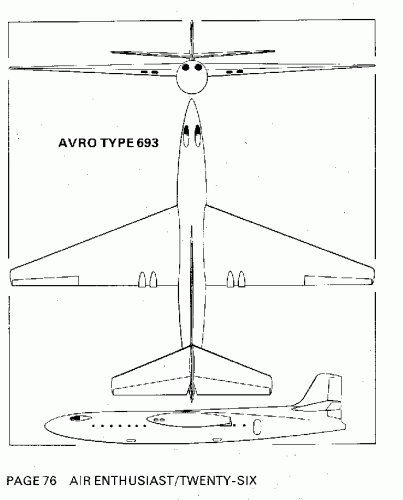From ‘Stuck on the Drawing Board’ by Richard Payne
Avro’s original projects against the Type 3 Specifications were the Avro 690 and 692 (or Avro XXII and XXIII), both powered by six Rolls-Royce Merlin 100 engines. These were superseded by the Avro 693 in 1945, which began life powered by four paired Rolls-Royce Clyde turboprops with contra rotating propellers. This paired option was then dropped for safety reasons by the time an order was placed for two prototype 693’s in April 1946. But the project evolved with proposals for Armstrong Siddeley Python turboprops, and then, finally four Rolls-Royce AJ65 (later Avon) turbojets).
The 693 was a large airliner and by December 1946, the design featured a fuselage some 110ft long with a high wing 135ft span, and wing area of around 2,700sq.ft. It was larger than the other jetliner proposed by the Brabazon Committee, the Type 4 project that became the Comet, and could carry forty day or twenty night passengers. The four Rolls-Royce AJ.65 engines, each 6,500lb static thrust, were integrated within the wing, with the tailpalne mounted midway on the fin. A cruising speed of 436mph at 40,000ft was envisaged. It would have a range of 3,513 miles with a 7,500lb payload. A decision was made to go ahead with the 693 in November 1946 but, as the project progressed, it became clear that BOAC would have no need for two jetliners. With the airline backing the DH106 (Type 4), it could not justify introducing two completely new and advanced jetliners into its fleet. On 1 January 1947, the carrier announced it was not going to order yet another British jet but it was not until July 1947 that the prototype orders for the 693 were cancelled and the type became the only one of the Brabazon Committee designs not to be built
Dec 1946 Spec Length 110ft, Span 135ft, Height 27ft 6in, Wing Area 2,700sq.ft
There is a drawing of the turboprop version but nothing of the jjet version.
Does anyone have any more on this aircraft?
Avro’s original projects against the Type 3 Specifications were the Avro 690 and 692 (or Avro XXII and XXIII), both powered by six Rolls-Royce Merlin 100 engines. These were superseded by the Avro 693 in 1945, which began life powered by four paired Rolls-Royce Clyde turboprops with contra rotating propellers. This paired option was then dropped for safety reasons by the time an order was placed for two prototype 693’s in April 1946. But the project evolved with proposals for Armstrong Siddeley Python turboprops, and then, finally four Rolls-Royce AJ65 (later Avon) turbojets).
The 693 was a large airliner and by December 1946, the design featured a fuselage some 110ft long with a high wing 135ft span, and wing area of around 2,700sq.ft. It was larger than the other jetliner proposed by the Brabazon Committee, the Type 4 project that became the Comet, and could carry forty day or twenty night passengers. The four Rolls-Royce AJ.65 engines, each 6,500lb static thrust, were integrated within the wing, with the tailpalne mounted midway on the fin. A cruising speed of 436mph at 40,000ft was envisaged. It would have a range of 3,513 miles with a 7,500lb payload. A decision was made to go ahead with the 693 in November 1946 but, as the project progressed, it became clear that BOAC would have no need for two jetliners. With the airline backing the DH106 (Type 4), it could not justify introducing two completely new and advanced jetliners into its fleet. On 1 January 1947, the carrier announced it was not going to order yet another British jet but it was not until July 1947 that the prototype orders for the 693 were cancelled and the type became the only one of the Brabazon Committee designs not to be built
Dec 1946 Spec Length 110ft, Span 135ft, Height 27ft 6in, Wing Area 2,700sq.ft
There is a drawing of the turboprop version but nothing of the jjet version.
Does anyone have any more on this aircraft?

